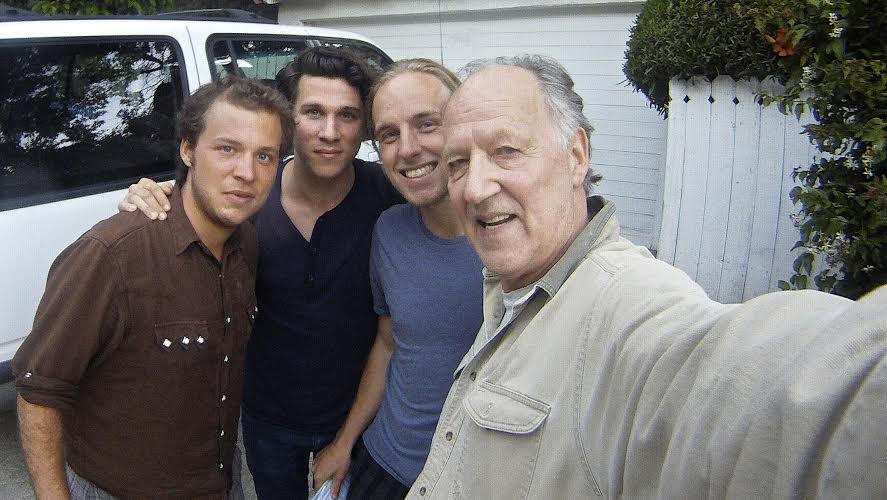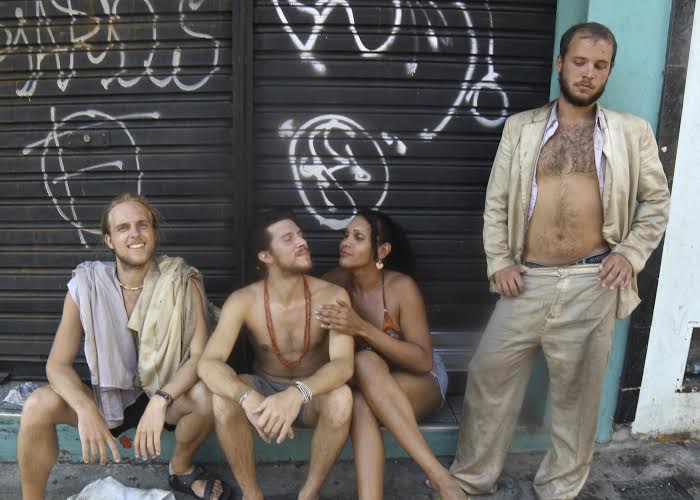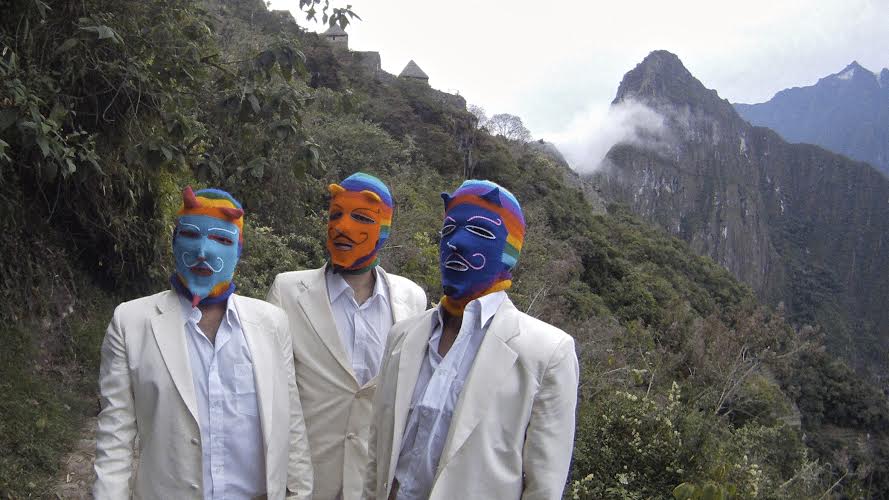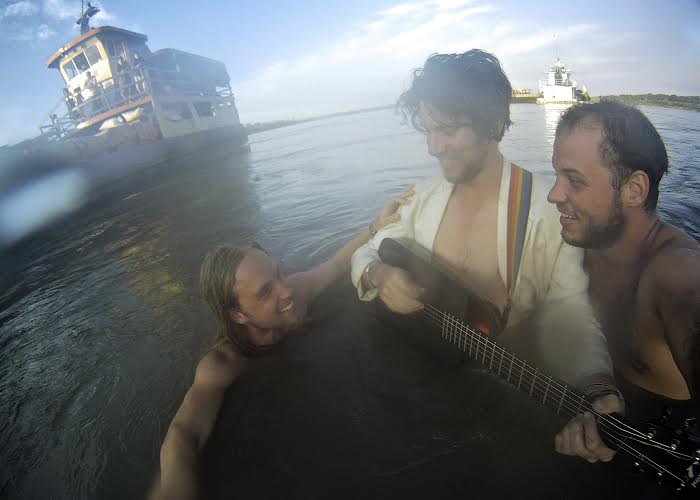“The Reconquest of the Useless” – Interview with the Filmmakers
By Yusumi Rodriguez

HAVANA TIMES – Over thirty years ago, the German director Werner Herzog filmed his most important movie, “Fitzcarraldo”, which earned him the 1982 Cannes Festival award for best director.
The film tells the story of Brian Fitzgerald (Fitzcarraldo), an eccentric man so obsessed with the opera that he decides to build a theater in the Amazon jungle. To do so, he needs to make money from the Amazon rubber trade, and for this enterprise he decides to transport a large steamship out of the water and over a mountain, with the aid of a large group of natives.
Carlos Fermin Fitzcarrald, the Irish-born Peruvian rubber merchant who inspired the film, used a smaller boat than the one in the movie and split it into several pieces in order to get it over the mountain. Herzog, nonetheless, insisted not only on using a larger one, but also on hauling it over the mountain in one piece, without taking it apart.
During the filming – in which several leading cast members were injured and the main actor had a complete falling out with the director – Herzog kept a diary, entitled “The Conquest of the Useless”.
Apparently one lone conquest of the useless wasn’t enough to confirm the uselessness of the entire process. Recently, three young North Americans – Harley Adams, Sam Pressman and Luke Wigren –also embarked on a journey of nearly 5,000 miles (8,100 kilometers) through the Amazon jungle, following in the footsteps of Herzog’s “Fitzcarraldo”, and “Broken Dreams”, Les Blank’s documentary about the filming of “Fitzcarraldo”.
An adventure of this kind could only be termed “The Reconquest of the Useless,” and that in fact is the title of the documentary that these three young people presented at the recently concluded 37th Festival of Latin American Films.
 I had the opportunity (and the patience) to watch it in the Infanta Multicine. At the end of the screening, our editor Circles Robinson, who was also present, asked me what I thought of it. “Beautiful – and stupid,” was my reply.
I had the opportunity (and the patience) to watch it in the Infanta Multicine. At the end of the screening, our editor Circles Robinson, who was also present, asked me what I thought of it. “Beautiful – and stupid,” was my reply.
I wasn’t intending to write about this film, even though it provoked a lively debate amongst Robinson, myself, and a woman friend regarding the relationship between people from the First world and those of us from the Third world; the advantages that the former always hold in such a situation. This conversation left me standing in the doorway of the theater long enough to have a friend introduce Sam Pressman, one of the young creators of the documentary.
When he realized that I’m a contributor to Havana Times and that I was in the company of my editor, he implored me to write about the film. I asked him if he was sure he wanted me to do that, and he said yes, he was completely willing to risk the possibility that I tear his film to pieces.
Initially, it would have been an article about the uselessness, in my opinion, of making this movie that doesn’t go anywhere; about the impatience that it aroused in me at times… but also about the beauty of the images and its capacity to maintain the spectator’s curiosity. However, in the end, it became a dialogue with the three creators.
HT: Why make a movie about a process that you already knew was useless? (Herzog himself had told them they’d find “nothing” there.)
Luke: First, you’d have to ask: What is the use of art? – or, of life?
Sam: Many artists ask themselves sometimes what they’re working for.
During the process of filming there were conflicts amongst the three: Harley received a punch in the nose; Luke got sick. Further, they had a run in with the law in Machu Picchu.
 HT: At those moments, didn’t you think about giving up and sending it all to the devil?
HT: At those moments, didn’t you think about giving up and sending it all to the devil?
Harley: I think that the moments when you feel the greatest uncertainty whether your creation makes any sense are the best and the truest; they come when you’re doing something that is really important to you. When you feel secure, it’s very easy; you know that what you’re doing is good and that you need to continue. To be precise, Herzog spent four years in the jungle during the filming of “Fitzcarraldo” asking himself: “Should I really be doing this, shouldn’t I go home? This has no meaning, it’s a piece of shit. It’s a conquest that’s useless – Why am I doing it? It’s a burden made of dreams.” So, for us to have been there and not have asked ourselves the same questions would have been a lie. We had to go and be in that space of uncertainty regarding our creation. And it’s a beautiful space to be in.
Sam: You read that the real Fitzcarraldo split the boat into segments and that in addition he had no interest in the opera. Herzog took his inspiration from an opera house that was constructed in Brazil during that era. But the only interest of the real Fitzcarraldo was money, exploitation.
HT: Do you believe that this makes the fictional Fitzcarraldo better than the real one? Didn’t both cause problems? That boat got dragged over the mountain because of the fictional Fitzcarraldo.
Sam: I think that if we view Fitzcarraldo as the story of a dreamer that struggles for his dream, then absolutely, the fiction is better. But I believe there’s a dark side to that notion: as we say in the movie when we reach Machu Picchu, horrible things have been done in the world in the name of beauty. We can’t simply presume that the dreams of a dreamer are necessarily good. I believe that Herzog intends us to reflect on the question of dreams. In the Les Blank movie about the making of “Fitzcarraldo” there are some great moments in which he questions himself and says: “Even if I finish this task, if I manage to get the boat over the mountain, no one could ever tell me that what I have done is good.” I believe that the myth of Sisyphus was very important for Herzog and for us. For the Greeks, the beauty of the myth is in the moment in which he makes the rock roll down the mountain and he sees his task finished. Perhaps there’s also a beauty in the struggle that we shouldn’t discount.
 Harley: Be it Aguirre or Fitzcarraldo, Western cinema from Hollywood, Germany, or wherever has long been obsessed with stories of foreigners who come to this part of the world, We wanted to examine that history from within, to ask ourselves: if there’s some meaning to it, then how can we come as foreigners, but at the same time do it differently? How can we understand what has happened before us, and what those stories left behind? What is left of Herzog, of Fitzcarraldo, or Aguirre in this place? Because people don’t just come to the Amazon, make a movie, then leave and everything stays the same. People leave footprints behind. As a result, we can’t know the answer to your questions. Is it better that Fitzcarraldo should want to make opera? Is it better that Herzog has wanted to make a movie? Is it better that we have wanted to follow in his footsteps? We don’t know and I hope that we never do.
Harley: Be it Aguirre or Fitzcarraldo, Western cinema from Hollywood, Germany, or wherever has long been obsessed with stories of foreigners who come to this part of the world, We wanted to examine that history from within, to ask ourselves: if there’s some meaning to it, then how can we come as foreigners, but at the same time do it differently? How can we understand what has happened before us, and what those stories left behind? What is left of Herzog, of Fitzcarraldo, or Aguirre in this place? Because people don’t just come to the Amazon, make a movie, then leave and everything stays the same. People leave footprints behind. As a result, we can’t know the answer to your questions. Is it better that Fitzcarraldo should want to make opera? Is it better that Herzog has wanted to make a movie? Is it better that we have wanted to follow in his footsteps? We don’t know and I hope that we never do.
While I was watching “The reconquest…” I couldn’t avoid feeling uncomfortable about the indigenous people that appear in the documentary. They seem so ingenuous, as if expecting something from these western foreigners who are using them for their film and who will derive more advantage from them than any advantages that these native peoples could obtain. Also, the fact that the filming of Fitzcarraldo caused the conflicts that already existed between the different indigenous tribes to worsen, caused me to wonder what positive thing these foreigners bring to our continent. Is that a prejudice on my part? Maybe – but it’s just this line of questioning that leads me to one of the most important searches of the film’s creators, especially of Luke who has developed a thesis on the anthropology of tourism. He’s aware that in the process of chasing their dreams, westerners from the First World step all over the things they encounter.
Luke: I wanted to investigate whether tourism could be a good thing, not only for foreigners but also for the indigenous populations.
Sam: Do you remember what Carlos Pizarro says in the documentary? “Cuzco is a city for tourists.”
Luke: For me, basically tourism isn’t a good thing, and it continues the history of slavery and colonialism that began in the past. There are the big companies that exploit the resources of these countries: the trees, the oil. They think only about taking resources out.
HT: As tourists, do you think you brought anything good to the native population while you were making this movie?
Luke: We can’t really judge whether this was better than some other type of tourism, but it was a question that we asked ourselves.
HT: I understand that it can be an uncomfortable question….
Harley: Actually, we wish that everybody would ask themselves these questions. In Cuzco there’s only the other type of tourism: the big, very expensive hotels, where guests are with other people from the United States, Germany and other First World countries. They encounter the native inhabitants up close only to buy souvenirs, bargain for the price of a necklace, take a picture and leave. That’s the kind of tourism that generally happens here. There are also those who go in order to convert people to Christianity, and the drug traffickers. We’re none of those things, and I don’t know whether what we did is better or worse, but it seemed to us more honest to invite the indigenous people to play guitar with us, to share our food and to ask that they let us share their food, that they invite us into their homes. We invited them to get into the boat with us to participate in the film and to use the camera. We wanted to try to break through that separation of worlds that tourism creates, through our interaction.
Also, the children that were with us in the boat don’t live naked in the jungle but in cities with cell phones, the Internet and all the things that we know about. They like the same movies that we do.
 Luke: We wanted to interact with them as if we were children too, making art together.
Luke: We wanted to interact with them as if we were children too, making art together.
Sam: John Waters, a North American movie director, is interested in topics like racism and homophobia; he argues that the only way for people to really understand the world outside themselves would be to live in the neighborhoods of those they consider different. If you never put yourself in places outside yourself, you’ll always think from the perspective of what you have experienced, what your culture tells you is true. Luke has had a great impact on me by helping me to examine and question our subjectivity. In theory, the movies constitute another form of tourism. They can help us to expand our consciousness and to understand other worlds. But all too often, because of the monoculture and the media representations, we believe only in the categorizations that lead to fear. This is a form of tourism that can create more honest forms of interaction so that people learn more and begin to see themselves as family in this global house that we share.
HT: One final question – Whose idea was it to make this movie?
Harley: I liked the idea of us traveling together and said: “Let’s look for something to do.”
Luke: I had this notion. Following four years in the University, I was thinking about tourism. I wanted to investigate the face of tourism that can break through all the borders and the hierarchies in the global world. In world history, tourism has advanced revolutions: there are no revolutions if we’re prisoners in our minds, in our countries.
Harley: I believe your last question is very relevant for us right now in Cuba. How can we avoid being just more North American tourists in Cuba? It’s something we think about a lot. The short answer is the movies. We’ve been watching fabulous movies in Havana, movies from the country, interacting with the people.
Sam: We don’t see much Latin American cinema in the United States.
HT: That’s something that also concerns the Latin American directors. Not only are their movies not shown in the US, but they’re not presented here on the continent either. In general, only the Hollywood productions are seen.
Sam: We believe this festival [which takes place in the first half of each December] is a great opportunity to watch Cuban and Latin American films.
Harley: We’re very happy to be here.
Sam, Luke and Harley have made other short films together, but this is their first feature length film. All three of them studied at Stanford University in California: Sam studied film; Luke, anthropology; and Harley studied art history.





